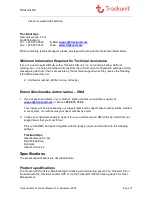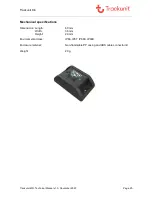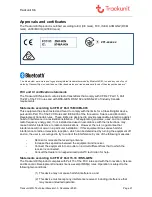
Trackunit Kin
Trackunit KIN, Technical Manual v1.0, November 2020
Page 10
The transmitter power is very low and as such, the device is exempted for routine evaluations and
body worn positions for the Trackunit Kin are not required by either the IEC 62311 or FCC part
2.1091, IEEE or ICNIRP requirements for operation in the Bluetooth LE band.
Battery Safety Information
Adhere to the following guidelines to avoid the risk of fire or explosion:
1. Dispose of the used Trackunit Kin units with batteries battery according to the
instructions provided with the battery.
2. Do not drop, puncture, disassemble, mutilate, or incinerate the Trackunit Kin as it may
affect the safety of the battery inside the unit.
3. The battery safety ensures that there is no risk* associated with the battery in the
temperature range from -40°C to +85°C but the battery lifetime can be seriously affected or
even lead to internal permanent damage of the battery for temperatures above +70°C.
* The risks are: No leakage, No venting, No disassembly, No rupture or No fire.
Delivered standard content
The delivered standard package content includes the following items:
10 x unit of the model type Trackunit KIN
1 x short installation guide.
Kin BLE Tag (Beacon)
Trackunit Kin is engineered from the ground up, to operate as a Bluetooth Low Energy Tag also
known as a “Beacon”. Kin “advertises” information with a fixed interval as a Beacon.
The entire Bluetooth BLE beacon concept is built around beacons transmitting packets of data that
are picked up by a compatible receiving Bluetooth devices (Gateways), in this case the
Trackunit
TU600
and
Mobile Devices using the Apps and services provided Trackunit
. All data are sent
to the back to Trackunit Iris, as the platform of construction powering the available services
launched with Trackunit Kin.
BLE uses the same spectrum range as Bluetooth Classic (2.400–2.4835 GHz ISM band) but on a
different set of channels. In order to save energy and provide higher data transfer speed, the
Bluetooth BLE communication framework consists of 40 frequency channels, separated by 2MHz.
3 of these channels are the primary advertisement channels while the remaining 37 channels are
secondary channels, also known as data channels.
The Bluetooth communication starts with the 3 primary advertisement channels and then offloads
to the secondary channels. To prevent narrowband interference problems, BLE uses frequency
hopping via digital modulation techniques or direct sequence spread spectrum to counteract.
While the beacons don’t listen for a response, the receiving device can perform actions based on
the beacon’s instructions. This includes, and is not limited to, things like check-ins on social media,
location-based actions, push notifications or sending data via the user’s Internet connection.











































